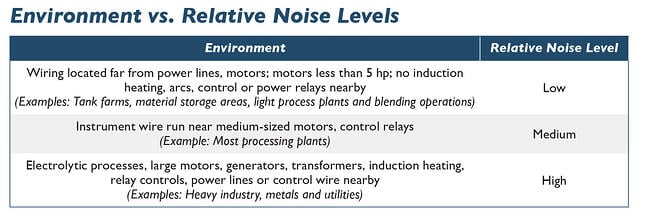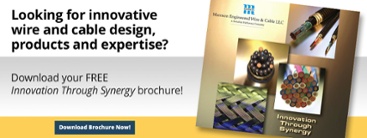Understanding Noise Levels and Installation Considerations
In part one, we discussed the four types of noise frequently found in instrumentation circuits (i.e., Common Mode, Cross Talk, Static and Magnetic) as well as the methods used to correct the problems they cause.
Next, we discuss the types of noise levels found in various environments and some installation considerations that will help you mitigate or completely eliminate the noise problems.
The table below classifies several environmental areas as having low, medium or high noise levels. This is intended to give a relative indication of how much noise is expected in a particular installation and how far to go in protecting against noise for the particular instrumentation circuits involved. As always, your results may vary.

Plant Installation Considerations
Besides the electrical problems that must be considered in choosing the proper wire and cable, you should also consider what a particular wire or cable installation must withstand from a mechanical standpoint. Here are a few to keep in mind:
- If a cable is being installed in an open tray, or ungrounded, armored or ER rated cable should be provided to protect against damage from crushing or the impact of falling objects.
- If the cable is to be pulled a great distance, suspended from two points or buried where shifting ground will cause tensile forces on the cable, an armor that acts as a strength member should be considered.
- Armoring should be used where crush and impact resistance is required.
- Where tensile strength is important, served wire armor will provide this protection, as well as crush and impact resistance.
Precautions to take during design
Precautions taken during design, engineering and installation can also reduce the effects of noise considerably. For example:
- Routing of instrument cables away from noise sources such as power cables, motors, generators, and any arc-producing equipment will greatly reduce the chances of noise pickup.
- Putting signals pf the same relative strength into the same cable and excluding any higher level signals will reduce the chances of cross talk.
- Shielding of data transmission circuits will reduce pickup by nearby instrument circuits.
- Twisting of control and power cables will reduce the magnetic noise pickup in nearby instrument circuits.
- Separation of instrument circuits from noise sources will reduce the noise problem considerably, as both static and magnetic fields fall off fairly rapidly as distances from the source is increased.
Ground Rules for Shields
Where shields are employed in both the single pair wires and in multi-pair cables for noise protection, there are some important ground rules to follow:
- To protect against common mode noise pickup within the wire and cable, a shield circuit should be grounded at the point where the instrument circuit is grounded and isolated from all other grounds (i.e., with a grounded couple, ground the shield on the extension wire at the couple).
- As the shield circuit is carried back to the control room through a junction box and a multi-pair cable, be sure to connect the pair shield in the cable to the single pair which leads to the couple without grounding the shield in the junction box or connecting it to any other shield (on other pairs).
- The shield should not be grounded in the control room.
- Ground all shields. An ungrounded shield will not provide noise protection.
- Ground a shield at one point only.
I hope this tutorial on how to control noise in instrumentation circuits has provided the level of detail you need to solve those pesky noise problems in your various applications. If you run into other types of problems or need further assistance, I welcome you to contact me. I’d be glad to help.
See also:
3 Basic Steps to Selecting the Right Thermocouple Wire for Your Application
Everything You Wanted to Know About Thermocouple Theory and Chemistry (but Were Afraid to Ask)
 Accuclave Tracking
Accuclave Tracking
